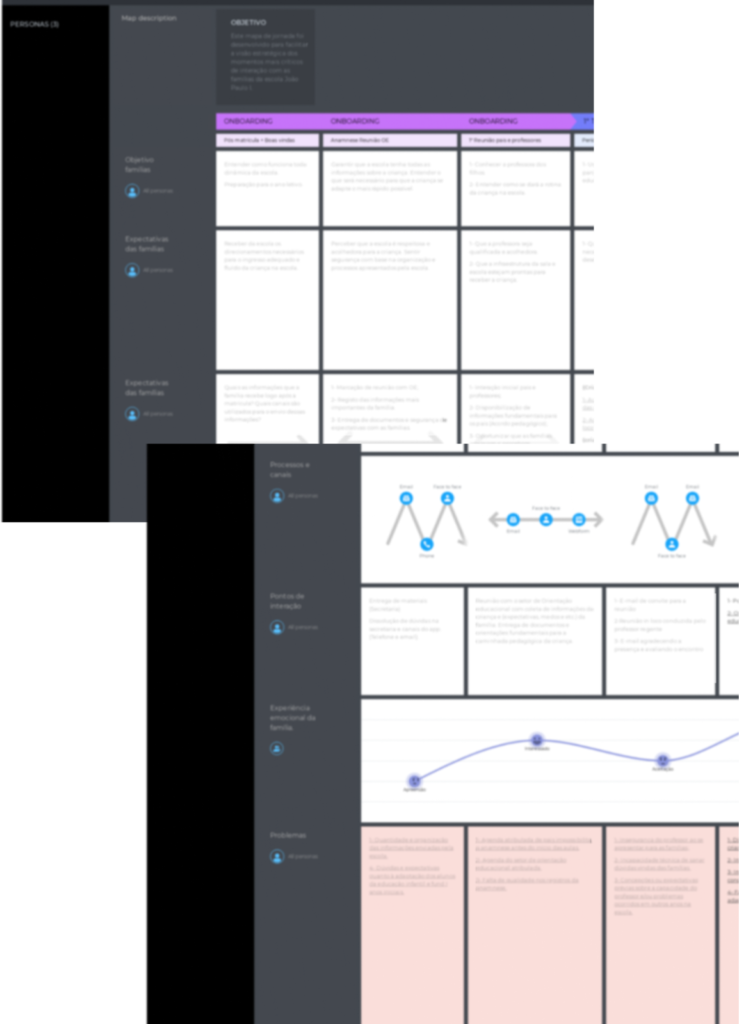In Brazil, private schools are not just educational institutions—they are thriving businesses. With families increasingly involved in their children's education, the relationship between schools and families has become more challenging. This shift threatens private schools with the potential loss of current clientele and a decline in new student enrollments.
Seeking to address this issue, Daniel Ramos, a CX lead at Colégio Arvense, focused on improving the family's experience at various touchpoints with the school.
Daniel leveraged customer journey mapping and UXPressia as a visualization tool to organize the client experience data he had, discover the interactional problems the families were facing, and formulate practical suggestions to share with the school staff.
What started as a private project brought tangible results and inspired other private schools to launch similar projects.
Contents
Turning the spotlight on families
Local educational institutions have always had trouble dealing with families, but the pandemic complicated things, intensifying parental involvement in education.
“During the pandemic, different services were happening online, and our students' parents could see how things were done,” Daniel explains. “They got close to the practice, and now they criticize teachers' work without all the context and details.”
Recognizing that parents, who ultimately decide where to invest their money, needed to feel more involved and informed, the school where Daniel worked aimed to improve its interactions with families.
“Parents are the clients, and they decide where they put their money. They should have their voices heard.”
Daniel was tasked with facilitating interactions between the school and families.
“My job was to ensure that the families have the information to judge whether we are doing well in every important interaction.”
Daniel started by conducting staff training, during which he discussed the families' experiences and suggested ways to enhance them. However, he found that his colleagues struggled to visualize the issues.
Giving journey mapping a try
Daniel decided to wrap the data in a more organized, visual format. To address this, he decided to use journey mapping, a technique he discovered in an online CX course.
The lecturer also mentioned an online journey mapping platform, UXPressia, that was worth trying. After checking out the platform and reading the company's blog articles about the methodology, Daniel decided to test the journey mapping waters by running a private project.
“If I were to say something like, "Hey, let's build a journey map, incorporate the changes based on its insights, and see the results in a year,” it won’t work.”
Being limited in time and needing quick results proving the project's value to himself and his colleagues, Daniel decided to concentrate on the onboarding part of the buyer journey.
“Onboarding is the beginning of the relationship, especially for parents with little kids. They're very engaged in school. They want to verify that their school choice is good for their kids. Something families don't understand or know from the beginning may become a big problem in a few months, ultimately leading to switching schools. By preventing future problems, the schools can get more profit.”
Moving in the right direction
In the early stages of his project, Daniel received acknowledgment that he had picked the right path. He created some personas representing families with similar attitudes and showed them to teachers, who said that these personas reflected the actual families.
Daniel visualized the onboarding interactions in UXPressia, populating the map with the data reflecting the actual families’ experiences. This visualization gave him a clear picture of the interactions between the school and families.
“UXPressia helped me get a strategic view of the interactions, having them laid out clearly and organized. When mapping, I also found mapping-related tips inside the platform very helpful.”
Looking at these interactions, Daniel could see what needed to be done to improve things, and he shared his ideas and insights with colleagues whenever he had a chance: during work presentations, small talks with colleagues, etc.
“The platform is a place where I can organize the insights of multiple people and put their perspectives together.”
The tangible results of Daniel's private project soon became evident. Teachers and staff began to see the value in his insights and suggestions.
"When you put everything on a map, the interaction gaps become visible. You can see what needs to be changed, like appointing the family to visit the school faster than we are currently doing."
That gave him buy-in from stakeholders to proceed with journey mapping, and the private project became part of the actual job.
Results in numbers
| Metrics | Results | |
| Annual new student acquisition rate | Increased by 33% in 2023 | |
| Number of active accounts | Increased by 13.7% in 2024 | |
| New students' NPS score | Is 8 points higher than the school’s average NPS | |
| CSAT score of the families that visit the school | 85% of the families are highly satisfied with the experience | |
| Percentage of parents who regularly read messages from the school | Increased to 78.93 % | |
Other important results
- Increase in the number of teachers asking for help to interact better with clients;
- Stakeholders opening more opportunities to prepare staff for important interactions with clients;
- New strategies to explain to clients the better steps to have the best experience with the school (new interactions, automated emailing, and microlearning initiatives)
- Countless contributions to the marketing team in producing content that directly relates to the school's customer experience.
Getting more attention
Daniel’s success at Colégio Arvense caught the attention of other private schools, leading to consulting opportunities. Now, he works with multiple schools, helping them improve critical interactions and train staff to deliver better experiences.

Daniel discovered multiple use cases for the insights derived from school journey maps, some of which include planning a communication strategy for a meeting with families, predicting (and eliminating) possible problems, and new employee onboarding.
“I give information at the right time to the school people having trouble with important interactions and help them fix the issues.”
Although schools recognize the value of journey mapping, they don’t want to be actively involved in the project by participating in mapping activities. So, Daniel remains a single active player in every project.
“They don’t want to participate in mapping sessions but love it when I show the details of important interactions that really matter to them.”
Daniel accepts the specifics and is confident about the direction he follows.
“I see that interactions are becoming lighter, and there’s more engagement in the things that are very important for the school.”
Future plans
Looking ahead, Daniel plans to continue consulting with private schools that engage him while expanding his focus.
His next project involves mapping the onboarding journey for new employees, which aims to enhance their experience from the start and reduce employee turnover.
As he reflects on his journey, Daniel feels prepared for larger projects and new challenges in the future.
“I feel like I'm getting ready for bigger projects.”





